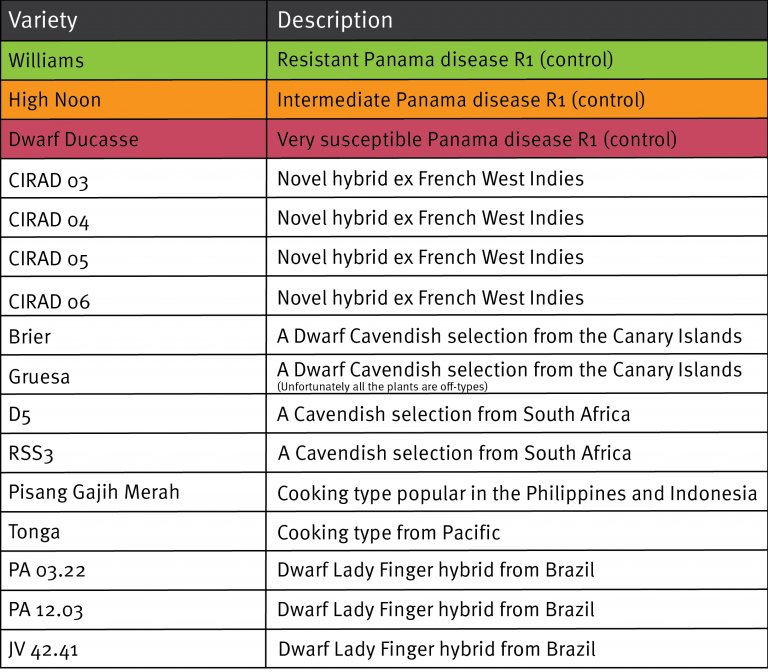Why screen for disease resistance to Panama disease race 1
If you are a non-Cavendish grower, then you are likely to already know the answer. Panama disease is caused by a soil borne fungus Fusarium oxysporum f.sp. cubense. The disease initially infects the banana plant through the roots, then moves through the plant into the vascular system inside the pseudostem. It eventually blocks the vascular tissue causing plant death. Different strains of the disease are known as races. Panama disease R1 is present in many production regions in Australia and infects varieties such as Lady Finger, Ducasse and some cooking bananas, but not Cavendish. Finding banana varieties with resistance to Panama disease R1 is the focus of the subtropical variety evaluations underway at Duranbah, NSW. Results from the Duranbah trial should be relevant to all subtropical growing areas with Panama disease R1.


History of the Duranbah trial site
Panama disease R1 wiped out a Lady Finger plantation on the current Duranbah site over 30 years ago. The land was then used to grow other crops, including avocados, and was fallow for several years before the trial began. Now the site is used for variety screening evaluations, with the initial trial planted in February 2012 as part of the Banana Plant Protection Project (BA10020).
The variety Lady Finger is very susceptible to Panama disease R1 and tissue cultured plants of this variety were grown on the site initially to confirm the continued presence of the disease. To guarantee the disease was evenly distributed when the trials were conducted, infected millet seed was incorporated into each planting hole, ensuring each plant in the trial is being assessed under the same disease pressure.
The initial trials included three phases:
Phase 1 – plants were grown with the sole purpose of determining if they survived Panama disease R1.
Phase 2 – varieties that showed Panama disease R1 resistance were grown to collect growth data including plant height, girth, cycling time and bunch data.
Phase 3 – standout varieties, called ‘best bets’, are being grown in semi-commercial plantings to determine ripening and handling conditions and to undertake consumer acceptance. Phase 3 is happening in the current project, the Improved Plant Protection Program for the Banana Industry BA16001.
Twenty-nine different varieties have been or are currently being screened for resistance to Panama disease R1. In BA10020, 13 varieties were tested and 16 are in the current trial which is part of BA16001.
Current trial
Sixteen local and imported varieties are currently being screened in the Panama disease R1 high pressure site. Varieties are rated according to their resistance or susceptibility to the disease by rating both the development of external and internal symptoms. External symptoms include yellowing of leaves and splitting of pseudostem, while vascular discolouration is rated internally at harvest or when plants die. Samples from plants suspected to be infected with Panama disease R1 are sent for laboratory diagnostics to confirm the presence of the disease.
The plants in this evaluation were deleafed and desuckered as per commercial practice and growth data, including cycle time, bunch weight, number of fingers and finger size are being collected.
Varieties that are showing good disease resistance at the plant crop stage in the latest screening trial include:
• Brier – a Dwarf Cavendish selection from the Canary Islands
• D5 – a Cavendish clone from South Africa
• JV 42.41 – a Lady Finger hybrid from Brazil.
The three ‘best bets’ varieties, PKZ, FHIA-17 and FHIA-25 were established in a semi-commercial planting in February 2018, in a separate block from the disease resistance evaluation trial. These varieties are managed in accordance with commercial practices to evaluate their agronomic performance under typical subtropical growing conditions. The first bunches were harvested in August 2019. Agronomic data is being collected from these plantings and the fruit is being used to develop growing, ripening and handling recommendations, and to undertake consumer acceptance testing. PKZ and FHIA-17 are dessert cultivars and FHIA-25 is a cooking banana.
And finally, due to interest from local markets the trial is also looking at some niche varieties such as Pacific Plantain and Santa Catarina Prata. Unfortunately, early observations indicate that these varieties are susceptible to Panama disease R1.




List of varieties

This research has been funded as part of the Improved Plant Protection for the Banana Industry Program (BA16001), which is funded by Hort Innovation, using the banana research and development levy, co-investment from the Department of Agriculture and Fisheries and the New South Wales Department of Primary Industries and contributions from the Australian Government. Hort Innovation is the grower-owned, not-for-profit research and development corporation for Australian horticulture.



